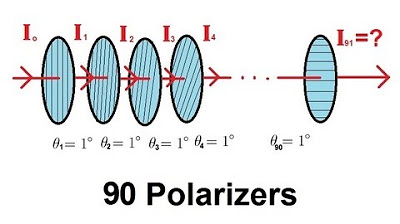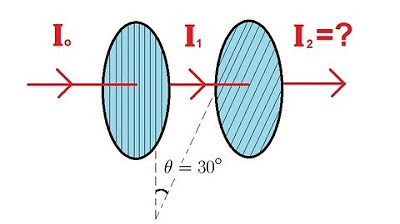The Polarizer | Physics with Professor Matt Anderson | M28-17
TLDRThe video script discusses the concept of polarizers and Malus's Law in the context of unpolarized light passing through a polarizer. The scenario involves sunlight, which is unpolarized, being filtered through an ideal polarizer with its transmission axis at a 30-degree angle to the vertical. The script explains that only half of the initial light intensity passes through the first polarizer due to the vertical polarization, and then applies Malus's Law to calculate the final intensity after passing through the polarizer, resulting in 5 watts per square meter from the initial 10 watts per square meter.
Takeaways
- 🔆 The problem involves an ideal polarizer with its transmission axis at a 30-degree angle to the vertical, placed in a beam of unpolarized light with an intensity of 10 watts per square meter.
- 📚 Malus's Law is introduced as the key principle to solve the problem, stating that the intensity of light after passing through a polarizer is proportional to the cosine squared of the angle (theta) between the light's polarization and the polarizer's transmission axis.
- 🤔 The discussion clarifies that Malus's Law was initially taught with two polarizers, but here it's applied to a single polarizer scenario, which initially seems different but is fundamentally the same.
- 🌞 Unpolarized light, like sunlight, has equal intensities in all directions and does not have a specific polarization direction, making it different from polarized light.
- 📉 The first polarizer only allows vertical polarization to pass through, effectively reducing the intensity of the light by half, from the original intensity (I_sun) to I_not.
- 📐 The angle of the polarizer's transmission axis relative to the vertical does not affect the intensity of the unpolarized light passing through it, as the light is not polarized in any particular direction.
- ⚖️ The intensity of light after passing through the polarizer is calculated by taking half of the original intensity (I_sun) due to the first polarizer's effect, which eliminates the horizontal component of the light.
- 🧭 The final intensity (I) of the light after passing through the polarizer is calculated as I_sun divided by 2, which in this case is 5 watts per square meter, given I_sun is 10 watts per square meter.
- 📝 The problem-solving approach involves understanding the effect of a polarizer on unpolarized light and applying Malus's Law correctly, considering the initial intensity and the angle of the polarizer.
- 👓 A practical example of using polarized sunglasses to look at the sun is given to illustrate that the angle of the polarizer does not make the sun appear dimmer, emphasizing the concept of unpolarized light.
- 🔍 The script emphasizes the importance of understanding the difference between polarized and unpolarized light and how this affects the calculation of light intensity after passing through a polarizer.
Q & A
What is the purpose of a polarizer in optics?
-A polarizer is used to filter light waves so that only waves vibrating in a specific direction pass through. It can convert unpolarized light into polarized light.
What is meant by the term 'unpolarized light'?
-Unpolarized light refers to light waves that vibrate in multiple directions or orientations, such as sunlight.
What is Malus's law and how is it applied in this context?
-Malus's law states that the intensity of light passing through a polarizer is given by \( I = I_0 \cdot \cos^2(\theta) \), where \( I_0 \) is the initial intensity, and \( \theta \) is the angle between the light's polarization direction and the polarizer's transmission axis.
Why is the first polarizer in the script described as having the purpose of only letting through vertical polarization?
-The first polarizer is described this way to illustrate that it filters out all but the vertically polarized light, which is essential for understanding how the second polarizer affects the light intensity.
What is the significance of the polarizer being rotated 30 degrees relative to the vertical in the problem?
-The rotation of the polarizer affects the angle \( \theta \) in Malus's law. However, since the light is unpolarized, the initial polarization direction does not matter, and the problem remains the same as if the polarizer was vertical.
How does the orientation of the polarizer's transmission axis affect the intensity of the light that passes through it?
-The orientation of the polarizer's transmission axis determines the angle \( \theta \) in Malus's law, which directly affects the intensity of the light that passes through. The intensity is maximized when the axis is aligned with the light's polarization direction and minimized when they are perpendicular.
What is the initial intensity of the unpolarized light in the script?
-The initial intensity of the unpolarized light, denoted as \( I_{sun} \), is given as 10 watts per square meter.
How much of the unpolarized light's intensity gets through the first polarizer?
-Since the first polarizer filters out the horizontal polarization, only half of the unpolarized light's intensity, which is 5 watts per square meter, gets through.
What is the final intensity of the light after passing through the polarizer with its transmission axis rotated 30 degrees?
-The final intensity is the same as if the polarizer were vertical because the light is unpolarized. It is half of the initial intensity, which is 5 watts per square meter.
Why does the rotation of the polarizer not affect the intensity of the light from an unpolarized source?
-The rotation of the polarizer does not affect the intensity of light from an unpolarized source because unpolarized light contains an equal mix of all polarization directions, so any rotation of the polarizer will still allow the same amount of light to pass through on average.
What would happen if the light were polarized instead of unpolarized in this scenario?
-If the light were polarized, the orientation of the polarizer's transmission axis relative to the light's polarization direction would significantly affect the intensity of the light that passes through, following Malus's law.
Outlines
🔆 Understanding Polarization and Malus' Law
This paragraph introduces the concept of a polarizer and its effect on unpolarized light. It discusses Malus' Law, which describes the intensity of light after passing through a polarizer. The scenario involves sunlight, which is unpolarized, passing through a polarizer with its transmission axis at a 30-degree angle to the vertical. The teacher seeks to understand the intensity of light after passing through the polarizer by considering the initial polarization state of the light and the orientation of the polarizer. The importance of Malus' Law in calculating the transmitted intensity is highlighted, and the teacher engages a student named Eudoria to discuss the application of the law in this context.
🌟 Calculating Light Intensity After Polarization
The second paragraph delves into the practical application of the concepts introduced in the first. It addresses the question of whether the orientation of the polarizer affects the intensity of unpolarized light, such as sunlight. The teacher clarifies that since sunlight is unpolarized, rotating the polarizer does not change the perceived brightness. The focus then shifts to calculating the intensity of light after passing through the polarizer, given that the initial intensity is 10 watts per square meter. The teacher explains that since the polarizer only allows vertical polarization to pass through, and unpolarized light has equal amounts of vertical and horizontal polarization, half of the light's intensity is transmitted through the first polarizer. The final step is to apply Malus' Law to find the intensity after the light has passed through the polarizer at a 30-degree angle, which is not directly calculated in the paragraph but set up for the next step in the explanation.
Mindmap
Keywords
💡Polarizer
💡Transmission Axis
💡Unpolarized Light
💡Intensity
💡Malus's Law
💡Cosine Squared
💡Vertical Polarization
💡Horizontal Polarization
💡Sunlight
💡Polarized Sunglasses
Highlights
Introduction of a polarizer question involving the transmission of unpolarized light.
Explanation of an ideal polarizer and its orientation at 30 degrees relative to the vertical.
Description of the unpolarized light source, such as sunlight, and its intensity.
Introduction of Malus's law for calculating the intensity of light after passing through a polarizer.
Malus's law formula presented as I = I₀ * cos²(θ).
Clarification on the purpose of the first polarizer in the context of Malus's law.
Discussion on the effect of the first polarizer allowing only vertical polarization.
Explanation of the relationship between the intensity of sunlight and the transmitted intensity after the first polarizer.
Mention of the factor of 1/2 for the intensity of unpolarized light passing through the first polarizer.
Analysis of the impact of the polarizer's orientation on the transmitted light intensity.
Illustration of the concept that the unpolarized nature of sunlight makes its intensity unaffected by the polarizer's angle.
Calculation of the transmitted intensity as half of the initial intensity of the unpolarized light.
Final answer provided: the transmitted intensity is 5 watts per square meter after passing through the polarizer.
Emphasis on the importance of understanding the polarization state of light in relation to polarizers.
Highlighting the practical application of polarizers in everyday scenarios, such as sunglasses.
Transcripts
Browse More Related Video

Physics 53 Polarization (4 of 5) Ninety Polarizers

Physics 53 Polarization (2 of 5) Two Polarizers

Physics 53 Polarization (3 of 5) Three Polarizers

Time of Flight in Projectile Motion | Physics

Where Does The Range Equation Come From?

Area of an Oblique Triangle - SAS & SSS - Heron's Formula, Trigonometry
5.0 / 5 (0 votes)
Thanks for rating: